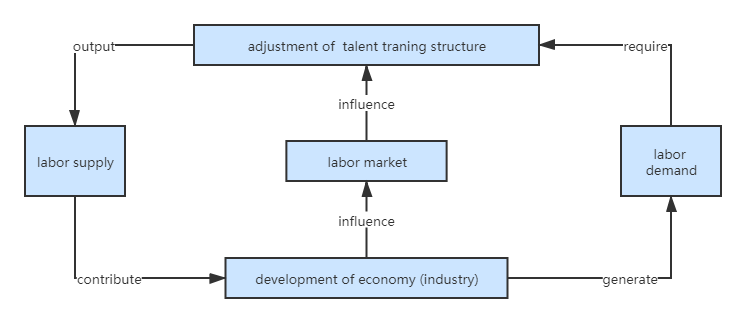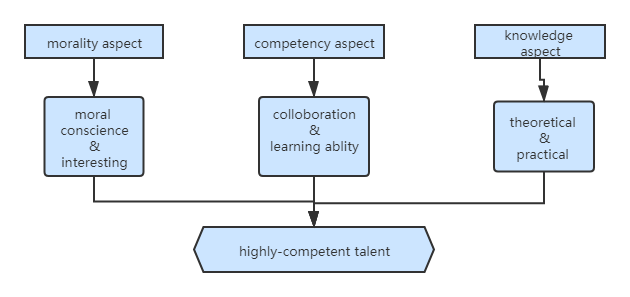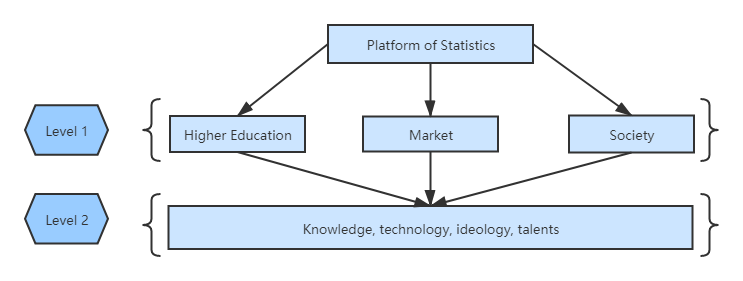Abstract
This article first introduces the changes and trends of labour market in digital economy, such as preference to highly and multi-skilled employees, looser organizational form and the realization of separate space in work, etc. Some occupations are facing the danger of elimination while some new jobs and working patterns appear due to the development of digital technololgy. As the important insitutions who supply human resources into the labor market, university is also facing challenges to cuiltivate adequate graduates to adjust to the new trends in labor market. A summary of current situation of digitalization in universities and expected competency of future graduates are given. It also mentions that talent training, labor market and economy should be seen as a dynamic cycle. In the end, the article also come up with a adjustable cultivation platform which based on mass data for higher education to fill the gap between the requirement of digitalized labour market and university graduates training.
Keywords: Digital economy, labor market, university, higher education, cultivation model
Introduction
Digital technologies and digital economy have stepped into the second stage, with various characteristics and more complex practical situations in reality. For example, it has made great changes towards the demand of labour market, with prefer to non-repetitive and mental skilled employees. Meanwhile, higher education is facing the transformation as well, for its own development and providing qualified gradates, who can meet the needs of labour market, into society. There are some studies on different aspects of how labour market has transformed and researchers also illustrates the digitalization in universities. However, there are not enough study on what cultivation model should universities adopt when facing the new demands in digitalized labour market.
Problem Statement
Since the term "digital economy" appeared in Tapscott's book in 1996 (Tapscott, 1996), research on the digital economy has been growing, including the OECD's publication of "Measuring the Digital Economy" (OECD, 2014). Specifically, the new challenges created by the digital economy are that workers need some deeper skills development to enable individuals to assess new situations more adaptively, to adapt their thinking, and to know where to go for information and what to do with it (IMF, 2018). Recent empirical evidence further suggests that the wave of machine replacement due to technological advances has led employers to pay more attention to, and be willing to pay higher levels of remuneration for, labour force qualities that cannot yet be fully replaced by AI in the short term, such as social cognition (Deming & Kahn, 2018).
Reigeluth (2019) argues that each transition in society has a different need for education, and that the paradigm of higher education has thus evolved from the 'one-room-schoolhouse' of an agricultural society to the 'factory models of school' of an industrial society to the 'knowledge work' of the information society. While the first three industrial revolutions were manufacturing paradigms driven by a single technology, Industry 4.0 is the "nuclear fusion" effect of the convergence and superposition of digital technologies such as artificial intelligence, big data, virtual reality, 3D printing, blockchain, 5G, etc., driving the intelligent interconnection of everything and thus forming a new manufacturing paradigm that integrates production and use (Yang, 2019). This will lead to disruptive changes in the way people produce, consume and educate themselves.
The research problem is caused by the existing gap between current higher education cultivation model and the ever changing demand of digitalized labour market. It has been witnessed changes of labour market under the influence of digitalization and universities are taking methods towards the new situation.
Research Questions
To find conceptual solution for the problem of the existing gap between requirements of labor market in digital economy and higher education graduate, it is necessary to understand what are the trends of digitalization on labor market first; secondly, what influences has digital economy brings to higher education and finally, how can we use digitalization transformation to cultivate competent graduates to meet the need of a changing labor market.
Purpose of the Study
The purpose of the study is to state new circumstances of labor market, including its requirement to employees and newly scenes of working methods. Also, it is important to understand the operation and cultivation model of higher education in order to build a conceptual framework of a flexible university cultivation model which emphasizes on the train of competency, not only knowledge itself.
Research Methods
In the process of research, the article provides analysis on the basis of statistics of previous relevant studies. The use of theoretical method (analysis, generalization methods) helps to identify the characteristics of labor market demand in digital economy. Conceptual mapping is conducted to give a description of higher education cultivation model in facing digital economy.
Findings
One of the new patterns of employment in recent years is platform-based employment which prerequisite for realization is based on the development of digital technology. It is an employment pattern in which the internet platform, with digital technologies such as mobile internet, big data, and artificial intelligence, carries out large-scale activities such as organization, deployment and task assignment of workers and service consumption demands, thus realizing direct contact between workers and consumers.
Digital technology can not only organize labour transactions online, but has also started to extend to labour transactions offline. Platforms can connect decentralized demand for services with tens of millions of workers. The transaction costs for workers to obtain work and income are dramatically reduced and efficiency greatly increased. According to China National Information Center's report, the number of platform workers involved in the sharing economy increased by 34 million from 2015-2020, with an average annual growth rate of 9% (Sharing Economy Study Center, 2021).
With the development of science and technology, the requirements of the labour market for employees have also changed. On one hand, from the aspects of long-term trend in technological progress, skill-biased technological progress has become the norm. There is a significant positive incentive relationship between technological progress and the upgrading of workers' skills, leading to an increase in the demand for highly skilled labour and a decrease in the demand for low-skilled labour. On the other hand, in terms of job content, advances in digital technology have allowed the creativity, innovation and creativity of countless artisanal individuals to be fully exploited.
The report, Jobs of Tomorrow, published in the World Economic Forum, listed 7 profession clusters, which are care economy, data and AI, engineering and cloud computing, green economy, people and culture, product development, sales and marketing as well as content. Through analyzing what skills will be required in the future, they find that both the adoption of new technologies and the interpersonal interaction are important to obtain (Ratcheva et al., 2020). A related study by Oxford Martin School believes that “up to 45% of existing jobs in developed countries will be replaced by robots and computer software” within next twenty years, and 69% in India and 77% in China (Frey et al., 2016).
New patterns of employment in digital economy also come along with a looser form of organization in work. The development of digital technology, the application of big data and platform-based data sharing have greatly changed the way knowledge is produced and the speed of dissemination, accelerating the organization and socialization of individual knowledge (Wang, 2016). In the new employment pattern, with the help of a network platform across time and space, a person can work for more than one employer at the same time. The worker or employed person has more choice in terms of working hours, intensity of work and the degree of constraints to which he or she is subjected. As a result, the new employment organization has changed from a close relationship to one that can be both loose and close, giving workers more choice and greater control over their own working hours.
The most representative of a looser organizational form is the separation space in work environment. As digital technology makes it unnecessary to work on site, people and organizations are becoming separated in terms of spatial relationships. Traditional forms of work that were concentrated at the employer's premises are beginning to move towards distributed forms of work, mainly in the form of home working and online work anywhere. This allows individuals in remote locations to still access work opportunities through platforms. The development of digital technology has led to modular, hierarchical and elementalised work content. More and more companies are classifying their work, cutting it into relatively independent modules, and then using different approaches to get the work done efficiently, depending on the characteristics and importance of the module.
In the last two years, the explosion of Covid-19 has accelerated the development of digital technology-based teleworking, giving employees more autonomy and flexibility. This type of work often has the following characteristics (Human Resources Research Team, 2020a):
- Work feasibility: it is possible to work remotely at low or no cost. The practical situation also shows that the more non-standardized and mental work is available, the more suitable it is for remote work, while manual work is basically impossible to achieve remote work.
- Work portability: the degree of task completion in which remote work can still be completed with some efficiency.
Despite of the direct influence of epidemic, a survey by Garner in 2020 stated that 68% of digital native generations, which is the highest among all generations, prefer work remotely at least some of the times for reasons like saving time and money in commuting (Human Resources Research Team, 2020b).
In the age of digital technology, specific educational approaches and methods within universities have also been greatly changed. Currently, these changes are still mainly at the level of supporting educational and teaching tools, such as online school platforms, student registration information systems, library systems, research databases and other related learning support applications. These types of systems and technologies provide virtual supply and technical support for teaching and research and talent training. At present, the popular technology platforms in universities are mainly divided into three categories: one is the network learning platform developed by universities independently according to their free technical resources and capabilities; the second is the purchase of technical services from third-party platforms, typical examples being various scientific research databases, such as CNKI in China, ScienceDirect and so on; the third category is the outsourced construction of e-learning platform.
However, to cope with the new demand in labor market, universities need to do more to cultivate competent graduates who can meet the needs of the ever changing market. As a productive force and method, the impact of digital technology on the economic and industrial structure will be all-round. For universities, this not only means that the layout of related disciplines should be accelerated around digitalization, but also means that the new demands of industrial transformation brought by digitalization will greatly change the specific structure of discipline professional talents training, as shown in Figure 1.

From the perspective of the human resources market, the upgrading of the economy and industry will inevitably bring about new structural changes in demand, and the cultivation of talents in university disciplines must respond to the new challenges brought about by such structural changes in demand. And the graduates from universities, as labour supply, will contribute to the development of economy in the end. From the perspective of historical development, digital technology itself is in the process of continuous development and breakthrough, and this continuous development and breakthrough will obviously change the structure of human resources market demand. The structure of human resources training in higher education is bound to change with the development of digitalization.
For universities, to meet the new needs of the digital economy, adjusting the types of disciplines and specialties flexibly is a necessary guarantee for their sustainable development. In the digital era, when jobs are replaced by intelligent robots, innovative character and ability will become the core value of human existence, and such talents will become the scarcest resource in the labor market (Figure 2). For universities, only by improving the innovative character and ability of professional talents in disciplines can they maintain sustainable development in the era of digitalization and better meet the new changes in labor demand structure brought about by the transformation and upgrading of economy and industry.

At the same time, the market is not omnipotent, it is blind, spontaneous and lagging. There is a problem of market failure in the process of dynamic adjustment of university discipline majors (Tian, 2017). Therefore, it is also necessary to bring into the macro-regulation function of the government when upgrading the talent cultivation structure, so as to avoid the market failure of setting academic majors.
Digital technology has helped to move personalized education from concept to practice in terms of precise teaching and scientific management, making the training of talents in different disciplines more in line with their unique logic of knowledge operation. This is conducive to improving the structural ratio of highly qualified and innovative talents. With the continuous breakthroughs in digital technology, the impact of personalized education implementation is being further expanded, and the innovative character and ability of students will also be enhanced with the implementation of it (Edwards et al., 2018).
In order to meet the needs of market, universities need to cultivate personalized human resources based on diverse higher education values, breaking the boundaries of age, space and time, learning content, etc.; with data as the centre, allowing learners to freely choose knowledge modules, teachers, learning time, etc. A positive cycle of cultivation is formed (Figure 3).

Firstly, the focus of the cultivation model is the university smart services platform which based on mass data. This platform provides maximum services for learners to select and accurately access the resources they need, anytime, anywhere, through in-depth analysis, and continuously improves the learner experience. Level one are the elements who connected and directly influenced by the mass data that learners created. The future of higher education should shift from siloed universities to distributed, specialized and intensive learning centers of all kinds, forming a cross-regional and internationally distributed community of life learning center with different characteristics and types, integrating formal universities, social education institutions, enterprises, families and community education. The second level illustrates the goal of the adjustable cultivation model, which aims at mastering knowledge, creating advanced technologies, forming suitable ideology and fostering talents for digitalized society.
Conclusion
The labour market is an important driver of the transformation in higher education. Flexible employment, temporary employment and flexible working hours are the new norm in the labour market, Such flexible and fragmented forms of work, a digital job market and diverse occupational skills need to be matched by a unique human capacity for digital innovation and entrepreneurship. Universities should not stand still and wait for technology to change it, but go ahead of technology as creators and leaders of new thinking, knowledge and ideas in the world, always nurturing talent and serving society.
References
Deming, D., & Kahn, L. B. (2018). Skill requirements across firms and labor markets: Evidence from job postings for professionals. Journal of Labor Economics, 36(S1), 337-369. DOI:
Edwards, C., Edwards, A., Spence, P. R., & Lin, X. (2018). I, teacher: using artificial intelligence (AI) and social robots in communication and instruction*. Communication Education, 67(4), 473-480. DOI:
Frey, C. B., Garlick, R., Friedlander, G., Mcdonald, G., Wilkie, M., & Lai, A. (2016). Technology at Work. In Manufacturing Engineer. DOI:
Human Resources Research Team. (2020a). Accelerating Remote Work After COVID-19. Gartner for HR. https://www.bloomberg.com/opinion/
Human Resources Research Team. (2020b). Gen Z’ s Expectations Are Already Shaping the Future of Work. Gartner for HR.
IMF. (2018). World Economic Outlook, April 2018: Cyclical Upswing, Structural Change. International Monetary Fund.
OECD. (2014). Measuring the Digital Economy: A New Perspective. OECD. DOI:
Ratcheva, V., Leopold, T. A., & Zahidi, S. (2020). Jobs of tomorrow: mapping opportunity in the new economy. World Economic Forum, 79(10).
Reigeluth, C. M. (2019). Chaos Theory and the Sciences of Complexity: Foundations for Transforming Educational Systems. Springer International Publishing. DOI:
Sharing Economy Study Center. (2021). China Sharing Economy Development Report (2016-2021). State Information Center of China. http://www.sic.gov.cn/Column/557/0.htm
Tapscott, D. (1996). The Digital Economy: Promise and Peril in the Age of Networked Intelligence. McGraw-Hill.
Tian, X. (2017). The Market Failure in the Dynamic Adjustment of University Majors and Its Correction. Research in Education Development, 21, 16-23.
Wang, C. (2016). No TitleA New Type of Knowledge-based Industrialisation: Internal Logic and Path Options. Tianjin Social Sciences, 6, 101-105.
Yang, Q. (2019). Industry-Application Convergence - A Fifth Manufacturing Paradigm Driven by A Cluster of Intelligent Technologies. Bulletin of Chinese Academy of Sciences, 34(1), 32-41. DOI:
Copyright information

This work is licensed under a Creative Commons Attribution-NonCommercial-NoDerivatives 4.0 International License.
About this article
Publication Date
25 September 2021
Article Doi
eBook ISBN
978-1-80296-115-7
Publisher
European Publisher
Volume
116
Print ISBN (optional)
-
Edition Number
1st Edition
Pages
1-2895
Subjects
Economics, social trends, sustainability, modern society, behavioural sciences, education
Cite this article as:
Zhang, C. (2021). University’s Cultivation Model Transformation Under Labor Market New Trends In Digital Economy. In I. V. Kovalev, A. A. Voroshilova, & A. S. Budagov (Eds.), Economic and Social Trends for Sustainability of Modern Society (ICEST-II 2021), vol 116. European Proceedings of Social and Behavioural Sciences (pp. 2816-2823). European Publisher. https://doi.org/10.15405/epsbs.2021.09.02.314

